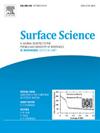单层石墨氮化碳负载Ag/Au单原子催化剂的结构性能和CO2电催化还原活性的DFT研究
IF 1.8
4区 化学
Q3 CHEMISTRY, PHYSICAL
引用次数: 0
摘要
本研究利用离散傅里叶变换研究了g-C3N4负载Ag和Au单原子电催化剂Ag- c3n4和Au- c3n4的结构特征和CO2还原性能。对所构建的结构进行了优化,并计算了电子密度和电荷密度差,证实了所构建的单原子催化剂的稳定性。电荷密度差分析表明,CO2在Ag-C3N4和Au-C3N4上发生化学吸附,导致CO2活化。进一步研究了这些SACs上电催化CO2还原反应(CO2RR)生成HCOOH、CO、CH3OH和CH4的微观机理。具体而言,对反应物、生成物和中间体的所有结构进行了优化,并计算了它们的吸附能、零点能和自由能的变化。随后,比较了Ag-C3N4和Au-C3N4催化剂的产物选择性差异。研究结果表明,Ag-C3N4催化CO2转化为CH3OH和CH4的效率相似,而Au-C3N4比HCOOH和CH4更有效地促进CO2转化为CH3OH。此外,通过分析生成四种类型C1产物的速率决定步骤的自由能变化值,我们发现Ag-C3N4比Au-C3N4具有更好的CO2催化性能。此外,研究了这两种催化剂上的析氢反应(HER),发现HER在两种催化剂表面都受到抑制。这一发现强调了这些催化剂对CO2的优先电催化还原作用。通过计算催化剂的能带和态密度,发现Ag-C3N4的能隙小于Au-C3N4的能隙。这一相关性表明,能隙越小,催化活性越强,Ag-C3N4电催化还原CO2的活性比Au-C3N4更高,进一步证明了这一点。结果表明Ag-C3N4和Au-C3N4均表现出较强的电催化CRR活性。这些结果为开发通过电催化高效还原CO2的单原子催化剂奠定了理论基础。本文章由计算机程序翻译,如有差异,请以英文原文为准。

A DFT study on the structural properties and CO2 electrocatalytic reduction activity of monolayer graphitic carbon nitride supported Ag/Au single atom catalysts
In this study, the DFT has been utilized to research the structural characteristics and CO2 reduction performances of g-C3N4 supported Ag and Au single-atom electrocatalysts, namely Ag-C3N4 and Au-C3N4 respectively. The constructed structures have been optimized and both the electron density and charge density difference have been calculated, confirming the stability of the constructed single-atom catalysts (SACs). As demonstrated by charge density difference analysis, the CO2 undergoes chemical adsorption on Ag-C3N4 and Au-C3N4, resulting in the activation of CO2. Furthermore, the microscopic mechanisms for the formation of HCOOH, CO, CH3OH and CH4 from electrocatalytic CO2 reduction reaction (CO2RR) on these SACs have been fully investigated. Specifically, all structures of the reactants, products, and intermediates have been optimized, and their adsorption energy, zero-point energy, and free energy changes have been calculated. Subsequently, the product selectivity differences between Ag-C3N4 and Au-C3N4 catalysts are compared. Our findings show that Ag-C3N4 catalyzes CO2 to CH3OH and CH4 with similar efficiency, while Au-C3N4 more effectively facilitates the conversion of CO2 to CH3OH over HCOOH and CH4. Furthermore, by analyzing the free energy change values of rate-determining step for generating four types of C1 products, we find that Ag-C3N4 exhibits superior CO2 catalytic performance over Au-C3N4. Moreover, the hydrogen evolution reaction (HER) on these catalysts has been investigated, revealing that HER is inhibited on both catalyst surfaces. This finding emphasizes the preferential electrocatalytic reduction of CO2 on these catalysts. Through calculations of the energy band and density of state of the catalysts, it is found that the energy gap of Ag-C3N4 is smaller than that of Au-C3N4. This correlation suggests that a smaller energy gap is indicative of stronger catalytic activity, which is further evidenced by the higher activity of Ag-C3N4 in the electrocatalytic reduction of CO2 compared to Au-C3N4. Our results reveal that both Ag-C3N4 and Au-C3N4 exhibit strong activity in the electrocatalytic CRR. These results establish a theoretical basis for the development of single-atom catalysts (SACs) that can efficiently reduce CO2 through electrocatalysis.
求助全文
通过发布文献求助,成功后即可免费获取论文全文。
去求助
来源期刊

Surface Science
化学-物理:凝聚态物理
CiteScore
3.30
自引率
5.30%
发文量
137
审稿时长
25 days
期刊介绍:
Surface Science is devoted to elucidating the fundamental aspects of chemistry and physics occurring at a wide range of surfaces and interfaces and to disseminating this knowledge fast. The journal welcomes a broad spectrum of topics, including but not limited to:
• model systems (e.g. in Ultra High Vacuum) under well-controlled reactive conditions
• nanoscale science and engineering, including manipulation of matter at the atomic/molecular scale and assembly phenomena
• reactivity of surfaces as related to various applied areas including heterogeneous catalysis, chemistry at electrified interfaces, and semiconductors functionalization
• phenomena at interfaces relevant to energy storage and conversion, and fuels production and utilization
• surface reactivity for environmental protection and pollution remediation
• interactions at surfaces of soft matter, including polymers and biomaterials.
Both experimental and theoretical work, including modeling, is within the scope of the journal. Work published in Surface Science reaches a wide readership, from chemistry and physics to biology and materials science and engineering, providing an excellent forum for cross-fertilization of ideas and broad dissemination of scientific discoveries.
 求助内容:
求助内容: 应助结果提醒方式:
应助结果提醒方式:


